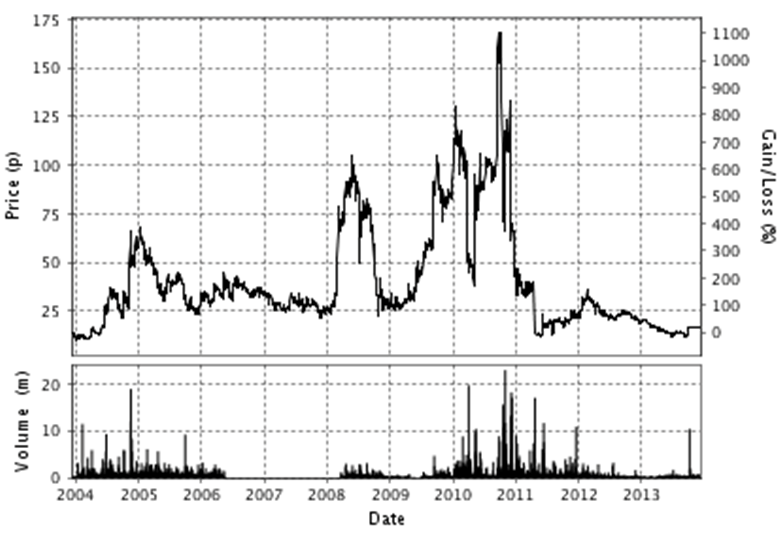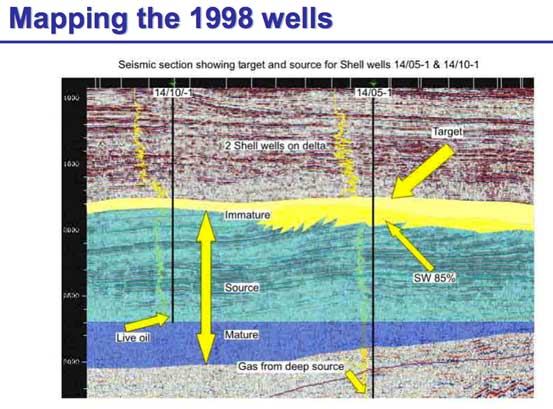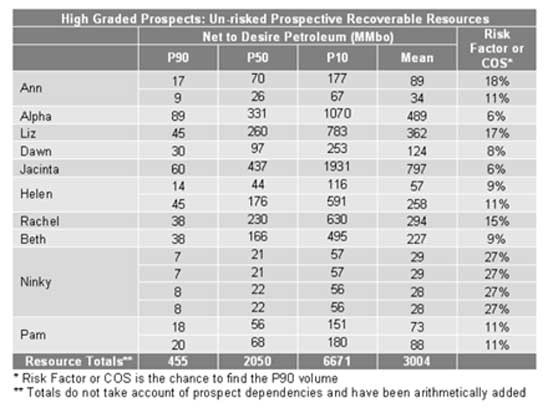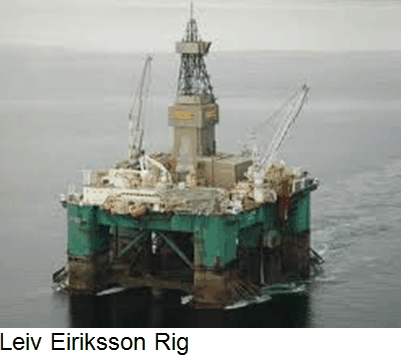An Obituary to Desire Petroleum
Dec 7, 2013 at 1:20 pm in AIM by contrarianuk

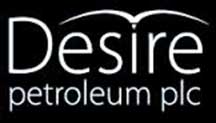 On 6th December 2013, the end game for Falklands hydrocarbon explorer Desire Petroleum (DES) finally came with the following RNS signaling the merger with fellow Falklands Islands oil explorer, Falklands Oil and Gas (FOGL).
On 6th December 2013, the end game for Falklands hydrocarbon explorer Desire Petroleum (DES) finally came with the following RNS signaling the merger with fellow Falklands Islands oil explorer, Falklands Oil and Gas (FOGL).
It might be argued that this signals an end of an era, but more likely the end of one chapter of the Falklands saga. Many private investors who bought into the Falklands dream a few years ago have either cursed or loved the company ever since (most likely the former!).
The Cancellation RNS
06/12/2013 7:00am
NOTICE OF CANCELLATION OF ADMISSION TO TRADING ON AIM
DESIRE PETROLEUM PLC
At the request of the company trading on AIM for the under-mentioned securities has been cancelled from 06/12/2013 7:00am.
Background to Desire Petroleum – the Falklands Islands oil adventure
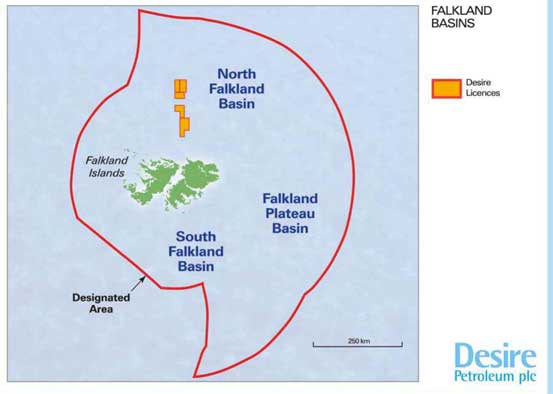 The company’s shares had a rollercoaster ride since their listing, peaking at around 170p in 2010 and delisting from AIM last week at 17p following their merger with FOGL.
The company’s shares had a rollercoaster ride since their listing, peaking at around 170p in 2010 and delisting from AIM last week at 17p following their merger with FOGL.
The shares exploded into life when Rockhopper Exploration (RKH) made their Sea Lion discovery, in the North Falkland basin, the area of interest for Desire’s exploration efforts, in April 2010. RKH’s Sea Lion well (14/10-2) was spudded on 15th April 2010 and was declared an oil discovery after encountering 53m of net hydrocarbon pay and recovering samples of medium gravity crude oil ranging from 26.4° to 29.2° API. The well was suspended for flow-testing and subsequently flowed oil at around 2000 barrels per day (bpd) in a well test in September 2010.
A second well test involving an Electric Submerged Pump (ESP) system and Vacuum Insulated Tubing (VIT) resulted in a stabilised flow rate of 5508 barrels per day during the test, and a maximum flow rate of 9036 barrels per day from the upper Sea Lion sandstones. Sea Lion at one point was expected to be as much as 850 million barrels, before further analysis and a competent persons report (CPR) gave 2C resources of 356 million barrels. Still a major oil discovery.
 During that period in 2010, there was an investor frenzy which started with expectations that the Falklands could turn into the next North Sea. The Sea Lion discovery during the 2010-11 drilling campaign turned out to be the high water mark for investors with several “dusters” denting the initial euphoria.
During that period in 2010, there was an investor frenzy which started with expectations that the Falklands could turn into the next North Sea. The Sea Lion discovery during the 2010-11 drilling campaign turned out to be the high water mark for investors with several “dusters” denting the initial euphoria.
The negativity has heightened in recent times after the poor valuation that Rockhopper achieved following their farm out deal with Premier Oil, the FTSE 250 mid cap oil group. The lack of interest by oil majors was to some extent seen as a result of the political risk associated with the Falklands as a result of the overtures of Argentina’s Cristina Fernández de Kirchner in trying to regain sovereignty of the islands from the U.K. – the so called Malvinas problem.
A history of Desire Petroleum
Desire Petroleum was founded in 1996 by Dr Colin Phipps, a former geologist for Royal Dutch Shell to participate in the first Falklands oil and gas licensing round (Phipps died on 10 January 2009 in a Birmingham hospital). The company is named after Desire, the ship, captained by John Davis, which discovered the Falkland Islands in 1592. The company was listed on the Alternative Investment Market (AIM) in the UK in 1998, raising £15 million at the IPO and having the ticker symbol DES.
 Desire Petroleum were was awarded licences for drilling in the Falklands in 1997, and first test drilling was carried out in 1998, with Desire participating in two wells out of a six well programme with Shell and Amerada Hess. The results showed oil/gas shows in 5 out of the 6 wells. 14/10-1 had live oil at surface 27°API and 14/5 32% gas at surface.
Desire Petroleum were was awarded licences for drilling in the Falklands in 1997, and first test drilling was carried out in 1998, with Desire participating in two wells out of a six well programme with Shell and Amerada Hess. The results showed oil/gas shows in 5 out of the 6 wells. 14/10-1 had live oil at surface 27°API and 14/5 32% gas at surface.
An analysts presentation in 2010 summarised the North Falkland basin prospects that the company were targeting with their “high risk, high reward” drilling schedule. The COS or chance of success was telling for many of the wells, with most under 20% i.e. less than a 1 in 5 chance of success. A real “wild cat” drilling campaign, one which ultimately produced disappointing results and a highly volatile share price in which many private investors probably lost a lot of money on several speculative bubbles. Information leaks were common, probably because of crew changes in the Falklands, with private investors seemingly the last to know.
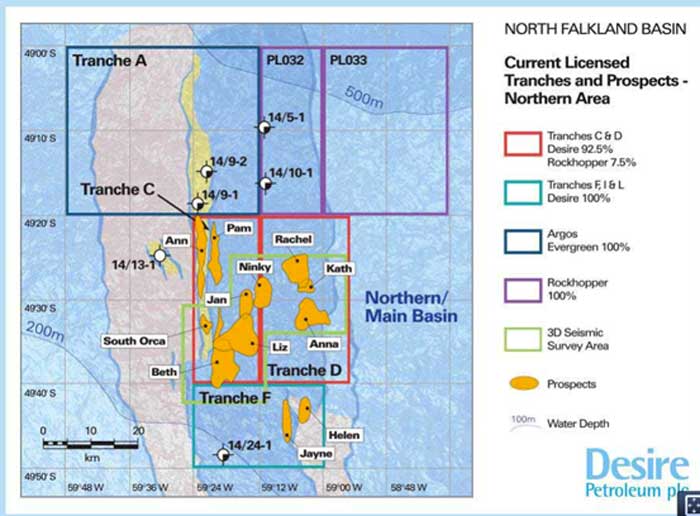 On the 19th February 2010, the Ocean Guardian rig arrived in the Falklands Islands. It is a third generation semi-submersible rig capable of operating in water depth up to 1,500ft with a maximum drilling depth of 25,000ft.
On the 19th February 2010, the Ocean Guardian rig arrived in the Falklands Islands. It is a third generation semi-submersible rig capable of operating in water depth up to 1,500ft with a maximum drilling depth of 25,000ft.
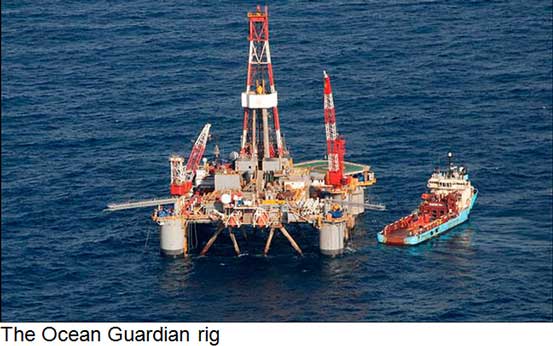 On the 22nd February 2010, the first well was spudded, Liz 14/19-1 and with the final drilling depth reaching 3667m with the result being thin intervals of gas/wet gas in a poor quality reservoir. Not what investors wanted to hear from the first well, but with a chance of success of 17%, not wholly unexpected by investors with any sense.
On the 22nd February 2010, the first well was spudded, Liz 14/19-1 and with the final drilling depth reaching 3667m with the result being thin intervals of gas/wet gas in a poor quality reservoir. Not what investors wanted to hear from the first well, but with a chance of success of 17%, not wholly unexpected by investors with any sense.
On 27th September, the Rachel 14/15/-1 well was spudded with the result again being disappointing with no hydrocarbons found.
On 12 November 2010 Rachel North 14/15-2 was spudded, with the preliminary result on 2nd December 2010 causing much excitement with the company announcing an oil discovery. “Preliminary data collected indicate that this well is an oil discovery. The company has run an initial suite of wireline logs and this together with the drilling data indicate that the well encountered a 349 metres gross interval from 2621 metres to 2970 metres of sands and shales with hydrocarbons ,of which 57 metres is net pay in multiple zones. The thickest zone is 8 metres thick with an average porosity of 20%. Other zones are thinly bedded and lower porosity but require further analysis from additional wireline logs to establish reservoir potential.”
 Commenting on the well, Stephen Phipps Chairman of Desire said, “It is highly encouraging that the initial results from the Rachel North well endorse both our findings and geological model from the previously drilled Rachel sidetrack well. This discovery combined with Rockhoppers’ Sea Lion discovery confirms our belief that the eastern flank play fairway in the North Falkland Basin is highly prospective and that further oil fields will be discovered in this area”.
Commenting on the well, Stephen Phipps Chairman of Desire said, “It is highly encouraging that the initial results from the Rachel North well endorse both our findings and geological model from the previously drilled Rachel sidetrack well. This discovery combined with Rockhoppers’ Sea Lion discovery confirms our belief that the eastern flank play fairway in the North Falkland Basin is highly prospective and that further oil fields will be discovered in this area”.
Unfortunately for Desire, it was not to be! Excitement turned to despondency when the results of the final wireline logging came through, on December 6th. The infamous “oil then water” incident – not the Desire’s boards finest hour!
The RNS said, However sampling of the main sand has shown that the hydrocarbons are residual and that the mobile fluid is water. Analysis of the formation water recovered by sampling indicates much lower salinity than anticipated and when this value is incorporated into a revised log interpretation it is confirmed that the sands are water bearing. The salinity impacts the resistivity of the formation water (Rw) which is used to calculate the saturation of hydrocarbons in sands. Using industry standard procedures, the initial interpretation was based on a calculated Rw value from a clear water sand only 55m above the target sand, of the same stratigraphic age and depositional setting. This calculated value was consistent with measurements from other wells in the basin. Unexpectedly, the actual Rw value in the sample taken from the main sand turned out to be markedly different and the target sandis now interpreted to be water-bearing. Formation pressures and sampling confirm the presence of good reservoir quality in the upper sands. A deeper target is still interpreted to be oil bearing, but the interval is thin and reservoir quality is poor.”
 On 18th December 2010, the Dawn/Jacinta 25/5-1 well was spudded both ultimately showing no hydrocarbons.
On 18th December 2010, the Dawn/Jacinta 25/5-1 well was spudded both ultimately showing no hydrocarbons.
On 29th March 2011, Ninky 14/15-3 started to be drilled with the result of 18th April confirming poor oil shows and a low quality reservoir.
On 12th October 2011, faced with depleted cash reserves after its 2010-11 drilling programme, the board resorted to farming out some of its North Falkland basin acreage PL004 to Rockhopper (RKH). Desire retained a 40% interest in the prospect.
On 28th November 2011, the Beverley/Casper prospect 14/15-4 was spudded as a joint well with RKH , with hydrocarbons finally being found on 13th December. The Well was located approximately 12.1 km to the south west of the 14/10-2 Sea Lion discovery well.
 A perfect Christmas present for the boards of directors and long suffering shareholders. At last an oil discovery for Desire shareholders, 15 years after the company was first founded!
A perfect Christmas present for the boards of directors and long suffering shareholders. At last an oil discovery for Desire shareholders, 15 years after the company was first founded!
The RNS said:
“The Well penetrated multiple reservoir targets: Beverley, Casper South, Casper and Sea Lion Main Complex and was drilled on Rockhopper operated licence PL004b. The Operator earned a 60% interest through the drilling of the Well.
According to the Operator, wireline logging and formation test data indicate the following:
All four targets are hydrocarbon bearing and no water wet sands were observed in the Well.
Highlights
· Total gross reservoir: 89m (292 ft)
· Total net pay: 57m (187 ft)
Beverley: Wet Gas Discovery
· Gross reservoir: 27.5m (90 ft)
· Net gas pay: 25.8m (85 ft)
· Net to Gross: 94%
· Reservoir quality:
-Porosity: Average 22%, Maximum 27%
-Permeability: Average 45mD, Maximum 144mD*
· No gas water or gas oil contact observed
Casper South: Oil and Wet Gas Discovery
· Gross reservoir: 24.5m (80 ft)
· Net oil pay: 11.6m (38 ft)
· Net gas pay: 8.5m (28 ft)
· Net to Gross: 83%
· Reservoir quality:
· Casper South Gas:
-Porosity: Average 25%, Maximum 30%
-Permeability: Average 212mD, Maximum 1327mD*
· Casper South Oil:
-Porosity: Average 27%, Maximum 34%
-Permeability: Average 1011mD, Maximum 5872mD*
· Gas oil contact observed at 2429m mdrkb
· No oil water contact observed
Casper: Successful appraisal well
· Gross reservoir: 12m (39 ft)
· Net oil pay: 2.4m (8 ft)
· Net to Gross: 22%
· Reservoir quality:
-Porosity: Average 16%, Maximum 24%
-Permeability: Average 33mD, Maximum 71mD
· No oil water contact observed
Sea Lion Main Complex (SLMC): Successful appraisal well
· Gross reservoir: 25m (82 ft)
· Net oil pay: 8m (26 ft)
· Net to Gross: 32%
· Reservoir quality:
-Porosity : Average 19%, Maximum 24%
-Permeability: Average 80mD, Maximum 195mD
· No oil water contact observed
So with the 14/15-4 well producing a successful result, further funding for additional exploration and appraisal wells became the focus for the company. On 3rd October 2013, Desire announced a merger with FOGL with DES shareholders owning 40% of the combined company. The terms agreed were 0.6233 FOGL shares for every DES share, so with a 27p share price for the former that made it 16.8p when the deal closed and was approved by regulators in December 2013. Quite a drop from the 170p levels seen in 2010 and back to where they were years before the 2010 drilling campaign started but better than the 12.25p seen before the deal was announced.
- Be careful about putting too much into high risk, high reward “wild cat” drilling campaigns in new frontier areas. The chances of success are often no better than 1 in 5 even with good seismic data. You can dream of gold, but often it is just a dream.
- Drilling is expensive around $1 million a day, so $30 million per well on average, even in the relatively shallow waters of the North. Expect plenty of fund raisings along the way for small company with institutional investors able to take part on highly favorable terms to reduce their risks. FOGL’s and Borders and Southern’s acreage in the South Falklands basin is much deeper and hence more expensive, requiring specialist drilling rigs like the leiv eiriksson used by these explorers in 2012.
- Take bulletin board rumours with a big, big pinch of salt. In the height of the 2010-2011 drilling campaign, the boards were full of so called “inside information” from apparent experts. In hindsight many of these turned out to be false and misleading. Predictions of big oil finds turned out to be dusters and vice versa. However, it was clear though that the Desire ship was very, very leaky with big drops in the share price prior to bad news being released in subsequent days.
- It takes a long time for oil to be brought to market. Rockhopper’s Sea lion was discovered in April 2010, but it will not be until 2017 when first oil starts flowing assuming that Premier Oil (who farmed into Rockhopper) sanction the project in 2014.
Despite these learnings and the Desire Petroleum disaster you can’t beat the adrenaline rush of investing in small cap shares who are doing wild catting – the crazy and fevered speculation on the bulletin boards, the anticipation of the 7am RNS. I await the next drilling campaign in the Falklands involving Rockhopper and FOGL/BOR in late 2014 once a new drilling rig has been contracted and moved to the Falklands Islands. It’s sure to be a ride. Lets hope for another Sea Lion, perhaps even in the South Falklands basin! It will be great for the Falklands and for UK PLC!
IMPORTANT
The posts I make are in no way meant as investment suggestions or recommendations to any visitors to the site. They are simply my views, personal reflections and analysis on the markets. Anyone who wishes to spread bet or buy stocks should rely on their own due diligence and common sense before placing any spread trade.


